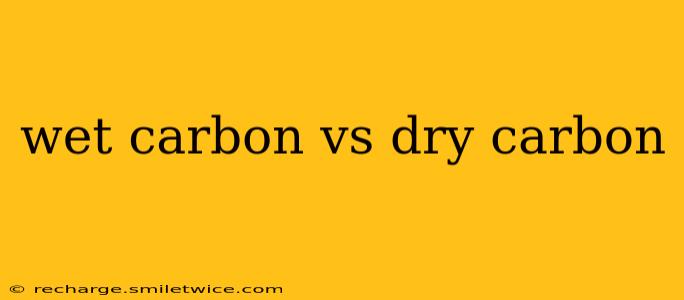Choosing between wet and dry carbon fiber for your next project can feel overwhelming. Both offer exceptional strength and lightweight properties, but their manufacturing processes, resulting characteristics, and ultimately, their suitability for different applications, differ significantly. This comprehensive guide will clarify the key distinctions between wet and dry carbon, helping you make an informed decision.
What is Wet Carbon?
Wet layup, the process used to create wet carbon fiber components, involves manually applying layers of carbon fiber fabric to a mold. These layers are then saturated, or "wetted out," with a resin, usually epoxy. This process is labor-intensive and requires skilled technicians to ensure proper fiber orientation and resin distribution to avoid voids and achieve optimal strength. The curing process, where the resin hardens, typically occurs in an autoclave or oven under controlled temperature and pressure.
Advantages of Wet Carbon:
- Complex Shapes: Wet layup excels in creating intricate and complex shapes, making it ideal for bespoke parts and applications with demanding geometries.
- Cost-Effectiveness (for small runs): For lower-volume productions, the relatively low tooling costs can make wet layup more economical than dry layup.
- Customization: The manual nature of the process allows for high levels of customization and flexibility in design.
Disadvantages of Wet Carbon:
- Labor Intensive: The manual nature significantly increases labor costs and production time, making it unsuitable for mass production.
- Potential for Defects: Variations in resin distribution and fiber orientation can lead to inconsistencies in the final product's strength and performance.
- Longer Curing Time: The autoclave or oven curing process requires significant time.
What is Dry Carbon?
Dry carbon, or prepreg carbon fiber, utilizes pre-impregnated (prepreg) carbon fiber fabrics. These fabrics are already saturated with resin, stored at low temperatures to maintain their tackiness, and then layered onto a mold. This process is more automated, allowing for faster production and improved consistency. The curing process is similar to wet layup, often employing an autoclave for optimal results.
Advantages of Dry Carbon:
- Consistency and Repeatability: The pre-impregnated nature ensures consistent resin distribution and fiber orientation, resulting in higher quality and more predictable performance.
- Automation Potential: Dry layup is more amenable to automation, leading to faster production times and lower labor costs. This is especially beneficial for mass production.
- Higher Strength-to-Weight Ratio: Due to the precise resin distribution, dry carbon often exhibits a higher strength-to-weight ratio compared to wet carbon.
Disadvantages of Dry Carbon:
- Higher Initial Investment: The cost of prepreg carbon fiber and specialized equipment is significantly higher compared to the materials used in wet layup.
- Less Flexible for Complex Shapes: While dry carbon can handle complex shapes, it is generally less adaptable than wet layup for highly intricate geometries.
- Shelf Life of Prepreg: Prepreg materials have a limited shelf life, requiring careful storage and inventory management.
Wet Carbon vs. Dry Carbon: Which is Better?
There's no single "better" method; the optimal choice depends entirely on the specific application and production requirements.
- Choose Wet Carbon for: Low-volume production, highly customized parts, and extremely complex shapes where flexibility is paramount.
- Choose Dry Carbon for: High-volume production, consistent quality and performance, and applications requiring a high strength-to-weight ratio.
What are the different types of carbon fiber?
Carbon fiber itself comes in various grades, each with unique properties affecting strength, stiffness, and cost. These grades are not directly tied to wet or dry layup; you can use any carbon fiber grade with either method. The choice of carbon fiber grade depends on the specific performance requirements of the final product.
What is the difference between prepreg and non-prepreg?
Prepreg refers to the pre-impregnated carbon fiber used in dry layup. Non-prepreg is the dry carbon fiber fabric used in wet layup, which requires the resin to be added separately during the layup process. The key difference lies in the resin's presence: prepreg has resin already applied, while non-prepreg does not.
How is carbon fiber made?
Carbon fiber production involves several complex steps, including the conversion of precursor materials (like polyacrylonitrile) into fibers, their carbonization at high temperatures, and then the final surface treatment. The details of the manufacturing process vary between producers, but these are the fundamental steps.
Which is stronger, wet or dry carbon fiber?
Generally, dry carbon fiber, using prepreg, results in a stronger and more consistent final product due to the precise control over resin distribution and fiber orientation during manufacturing. However, the quality of the wet carbon part is heavily dependent on the skill of the technician and careful attention to detail during the layup process.
By understanding these differences, you can select the appropriate carbon fiber manufacturing method for your specific needs, leading to a successful and high-quality final product.
